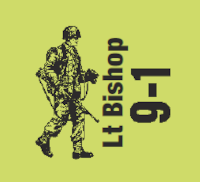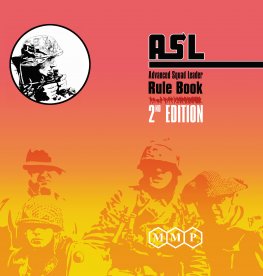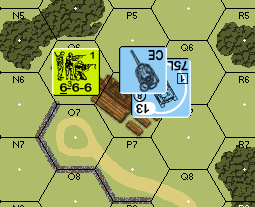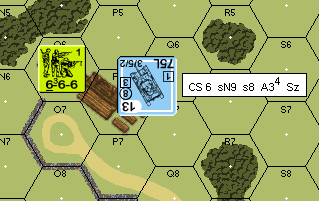
This article stems from a discussion that occurred on the ASL Discord server. A member pointed out the A11.11 Close Combat Table on the QRDC says Sequential Close Combat (CC) (A11.3) is resolved in this order: Ambush, AFV, Prisoner. They then asked if this was incorrect and it should instead be Prisoners, Ambush, AFV instead.
My first thought was Ambush (A11.4) should come first, and I fired off an answer to that effect. I quickly deleted the reply because I had a nagging suspicion it wasn’t that easy. I opened my rule book and dug into it. Turns out, it is a little more complicated than I originally thought.
Rules Dive

A11.12 covers Sequential CC. Generally, CC is resolved simultaneously. There are some circumstances which can interrupt this flow (Infiltration (A11.22) for instance). For this discussion, we will focus on Ambush, Vehicular (AFV), and Prisoners. Per A11.3, these are three instances where CC is not simultaneous but is instead sequential. Normally, each side declares all of their defending stacks and then each side declares how they will attack against some or all of those defending stacks. The Attacker then conducts his attacks, followed by the Defender. This order here is important in case Infiltration occurs.
In a sequential attack, each side still lays out all of their defending stacks first. Then the side going first declares his first attack. Each side can wait to see the results of all previous attacks before declaring their (next) attack. Each side must still abide by attacking limits (e.g. units can only attack or be attacked once [EXC: CC vs./by a vehicle]). As always, all units in the Location do not have to attack or be attacked (A11.12).
Sequential CC Order Of Operations
All of this has been pretty straightforward. But what happens when your AFV somehow ambushes Infantry advancing into its Location? Who goes first? As you might suspect, the rules cover this. Per A11.34, resolve these attacks per the rule number, the highest numbered rule going first. If there are multiple chances of Sequential CC, resolve Prisoners first (A11.33), then Ambushes (A11.32), and finally CC against AFV. Let’s see how this works in practice.
Example One

Refer to figure 1. Assume it is the CC phase and the American squad has passed it Pre-AFV Advance/Attack Task Check (PAATC). The squad advances into P6. The squad has no drm modifying its Ambush dr and rolls a 6. AFV have a +2 drm to their Ambush dr. It rolls a 1, yielding a Final dr of 3. The AFV has achieved an unlikely Ambush against the squad.
Since we resolve Ambushes BEFORE AFV (A11.34), the AFV will go first. The PzIV has a 5 FP CMG and a 2 FP AAMG. Per A11.62, it could combine these into a single attack against the American squad or use them to conduct two separate attacks. But recall, A11.12, non-vehicular CC targets may only attack or be attacked once. The PzIV attacks the squad with 7 FP against the squads Close Combat Value (CCV) of 5. This yields a 1:1 attack. Of course, the AFV could decide not to “stack” the two MGs into a combined attack, opting instead for a 1:1 (CMG 5 FP against the squads CCV of 5) or a 1:4 (AAMG 2 FP vs CCV 5).
If the squad survives the attack, it may attack back. When attacking an AFV, the CCV to MG odds do not matter. Compare the Attacker’s Final CC DR to the CCV to determine the outcome.
There ALWAYS An Exception

Refer to figure 2. This example is almost exactly the same as before, except a PzIV J replaced the PzIV H. The panzer is also BU this time. Being BU adds a +1 drm to the panzer’s Ambush dr. Assume there is no Ambush.
This will be a Sequential attack. The Americans attack first with a CCV of 5 against the panzer. Assume the PzIV survives.
The PzIV first attempts its Close Defense Weapon System (sN). If it rolls an Original DR ≤ 9, it will first attack the American squad with a 16 flat attack. Regardless of the outcome sN attack, if the American squad is still there, the PzIV can then opt to attack the American squad with its 5 FP CMG versus the squads CCV of 5 yielding a 1:1 attack. This can be particularly devastating if the American unit is first broken by the 16 FP attack. Keep this in mind when attacking German AFV with sN.
Guards And CC

Refer to figure 3. It is the German player’s turn. The German squad advances into the American unit’s hex. The Americans roll a 4 on their Ambush dr. Interestingly there are no drm for Guarding Prisoners. The Germans roll a 3. There is no Ambush. The American player, referring to the A11.11 Close Combat Table asserts this is Sequential CC since there are Prisoners in the Location. But is it?
Referring to A11.33 it is clear the answer is no. It would be sequential if the Prisoners were attempting to eliminate their Guard. That is not happening here. There is no Melee yet and the Guards are still in Good Order. If the German attacks the Americans, it would still do so with half FP because it is Guarding. It would defend at full FP. The Prisoner could not attack in this first round of CC. Should a Melee form with these units, A11.3 applies and the Prisoners (possibly together with other German units) can attack their Guards first.
Some Final Thoughts

The more I explored this, the more sense it made to me for the order of resolution. It takes some pretty convoluted circumstances to make the order of operations to not be intuitive. Refer to figure 4. The Concealed German unit is Adjacent to the American units. The German advances in. The Americans receive a +1 Ambush drm for the broken unit while the Germans receive a -2 drm for being Concealed. Further suppose the Germans are LAX. For Ambush drs, the Americans roll 1 and the Germans roll a 6. The final 2 vs 5 yields an American Ambush. How do we resolve this?
First, the Ambush creates a Sequential CC phase. But the Guards are broken. As such, the Prisoners may take a Normal Task Check and if they pass, they may attack their Guards. This creates a second Sequential possibility. Who goes first? The ambushing Americans or the Prisoners? Well, per A11.34, the Prisoners go first. I will not lay out all the attacks here as this is probably worthy of its own article. It is way more complex than it may appear at first blush. It might make for a great “what happens” discussion.
Conclusion
I hope you find this article helpful. It is funny to me how easy I thought the answer to the original question was. Then I dug into it and thought it was more complex than it actually is. The truth of the matter is you’ve probably always done this correctly. Situations where the “order of operations” truly matter are exceedingly rare in my experience. I don’t think I can recall a time where it mattered. Of course, I could have missed it.
Parting Shot
My next post will be on or about September 9, 2021. This will mark the one-year anniversary of my blog. In that time I have published 63 articles (64 counting this one) in that time. A guest author has contributed 3 of those. Some have been announcements of articles I have had published in other publications. I have done two “fireside” chats with vloggers. It has been a hell of a ride and I thank everyone who has joined me for the excursion. We’re just getting started. Until next time.


“The truth of the matter is you’ve probably always done this correctly.”
Er – you assume too much 🙂 I did not know that a German tank had the Sn and then a normal attack. I stopped at the Sn………………….
Many thanks for another article Jim. My game improves with every one – I just need to remember them.
Yup, new one to me also. Obvious when you read the article. Of course it can because the sN is an attack on the IFT not the CC table.
Slaps head….
The more you learn you, realise how little you know.
8/26 — I made a small update to this article. Klas points out that an sN does not add a +1 DRM when BU for CC attacks only (D13.3). Klas also points out that when attacking with the sN, no DRM apply (A11.622). I also cleaned up some minor typos but those changes did not affect the point of the article. Mea Culpa. — jim
Jim,
Thanks for another thought-provoking and informative article. The time you spend on helping to bring more clarity to understanding the ASLRB is much appreciated.
However, have one question regarding the PzIV H in figure 2 using its sN in the CC. You state that, “The PzIV first attempts its Close Defense Weapon System (sN). It must add a +1 DRM for being BU.”
I don’t see the -1 for being BU in D11.622 In fact, in the accompanying example it states the German’s sN “…IFT DR is a 7 resulting in a 2MC…” Which implies no DRM was added to the IFT DR, otherwise the result would have been a 1MC.
Also, I notice that in the SK version of the same rule (3.8 p. 18), it specifically says, “… (do not add +1 for being BU).”
What am I missing?
WRT the +1 BU DRM and the +2 IFT DRM, I made a mistake. I bet you have the first version of the article. I subsequently corrected it as noted above. Mea Culpa. — jim
Jim,
My apologies. I had your article open in a stale window, and therefore did not pick up that you had already addressed my question.
Again, I think you are doing the ASL community a great service.
Keep up the good work!
No worries Jack. Life is good. Sadly, I still make errors even after a year 😀 — jim
Wow. That’s a clear layout of a process that is more complex that I thought! Nicely done!
“There is ALWAYS and Exception”
Although this section doesn’t delve into tactics, the American Squad should forego CC attacks preventing the 16 IFT shot upon all occupants of the location and simply undergo a 1:2 “parting” CCV attack by the AFV.
With a 6ML, the likelihood of maintaining GO status is unlikely at the 16FP attack by the sN.
That is certainly one possible option, but these types of answers are impossible without knowing the Victory Conditions or prevailing situation at the moment a decision needs made. Perhaps the Americans win immediately upon eliminating the last Good Order German AFV. This may be the best chance the Americans ever get. Who knows. Without context, sound tactical discussion is impossible. It would take pages and pages to identify possible tactical considerations and enumerate possible options in response.
Tactical discussions are best done in the context of a game.